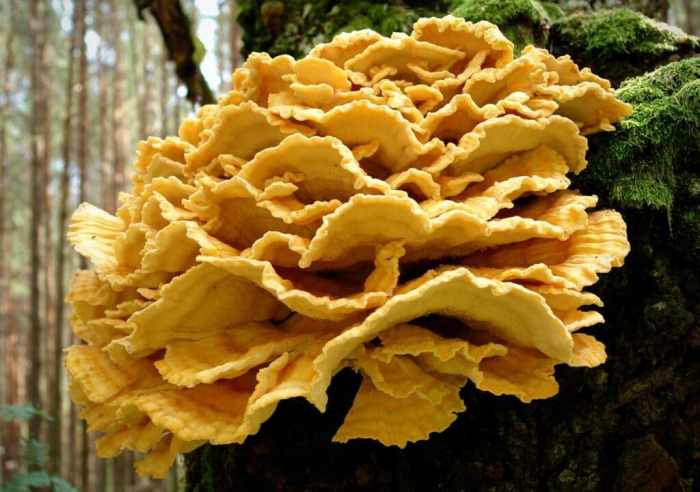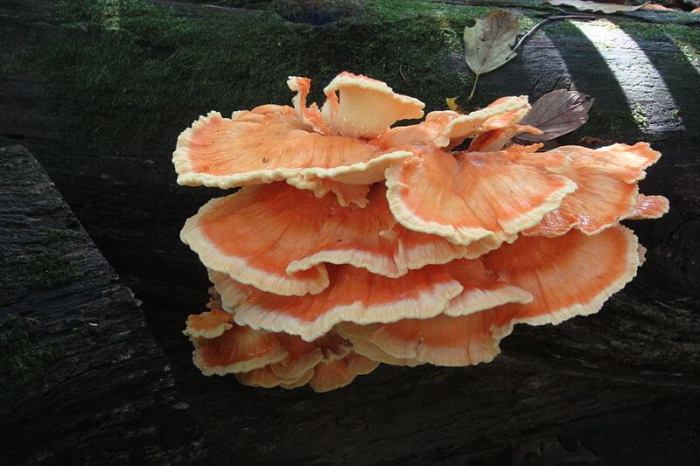
Embark on a culinary adventure with our comprehensive chicken of the woods recipe guide. From foraging and identification to delectable dishes and preservation techniques, this guide will ignite your passion for this unique and flavorful mushroom.
Dive into a world of culinary possibilities as we explore the nutritional benefits, cooking methods, and versatility of chicken of the woods. Whether you’re a seasoned forager or a curious cook, this guide has everything you need to make the most of this woodland delicacy.
Recipe Variations: Chicken Of The Woods Recipe
Chicken of the woods is a versatile mushroom that can be cooked in a variety of ways. Here are a few popular recipes:
Sautéed chicken of the woodsis a simple and quick dish that is perfect for a weeknight meal. Simply sauté the mushrooms in butter or olive oil until they are browned and tender. You can add other ingredients to the sauté, such as onions, garlic, or herbs, to taste.
Grilled chicken of the woodsis a great way to enjoy the smoky flavor of the mushrooms. Grill the mushrooms over medium heat until they are cooked through and slightly charred. You can marinate the mushrooms in your favorite marinade before grilling for extra flavor.
Roasted chicken of the woodsis a hearty and flavorful dish that is perfect for a special occasion. Roast the mushrooms in a preheated oven until they are browned and tender. You can add other vegetables to the roasting pan, such as potatoes, carrots, or onions, to create a complete meal.
No matter how you choose to cook it, chicken of the woods is a delicious and versatile mushroom that is sure to please everyone at the table.
Flavor and Texture
The flavor of chicken of the woods is often described as being mild and nutty. The texture of the mushroom is firm and slightly chewy, making it a good choice for dishes that require a bit of bite.
When cooked, chicken of the woods mushrooms release a slightly sweet liquid that adds to their flavor. This liquid can be used to make a delicious sauce or gravy.
The unique flavor and texture of chicken of the woods make it a popular choice for a variety of dishes, from simple sautéed mushrooms to hearty roasted dishes.
Nutritional Benefits

Chicken of the woods is a highly nutritious mushroom packed with essential vitamins, minerals, and antioxidants. It’s a good source of protein, fiber, and low in calories.
- Vitamins:Chicken of the woods is rich in vitamins B1, B2, B3, B5, and vitamin C. These vitamins play crucial roles in energy production, metabolism, and immune function.
- Minerals:It’s also a good source of minerals like potassium, phosphorus, magnesium, and zinc. Potassium supports heart health, phosphorus strengthens bones, magnesium aids in muscle function, and zinc boosts immunity.
- Antioxidants:Chicken of the woods contains antioxidants such as ergothioneine, beta-glucans, and polyphenols. These antioxidants help protect cells from damage caused by free radicals.
Potential Health Benefits
Consuming chicken of the woods may offer several health benefits:
- Boosts Immunity:Its high content of vitamins, minerals, and antioxidants strengthens the immune system and helps fight infections.
- Reduces Inflammation:Antioxidants in chicken of the woods have anti-inflammatory properties that may help reduce inflammation throughout the body.
- Supports Heart Health:Potassium and other minerals in chicken of the woods support heart health by regulating blood pressure and improving blood flow.
Foraging and Identification

Chicken of the woods is a common and widespread mushroom that can be found in forests throughout North America. It is a parasitic fungus that grows on oak trees, and it can be identified by its bright orange color and its large, shelf-like shape.The
chicken of the woods mushroom has a smooth, velvety cap that is typically 4-12 inches wide. The cap is often lobed or ruffled, and it can be either bright orange or yellow. The underside of the cap is covered with small, white pores.
The stem of the chicken of the woods mushroom is short and thick, and it is typically white or yellow.The chicken of the woods mushroom can be found in forests throughout North America. It is most commonly found in the summer and fall, and it can be found on both living and dead oak trees.There
are a few look-alikes to the chicken of the woods mushroom, but they can be easily distinguished by their color and their habitat. The false chicken of the woods mushroom (Laetiporus sulphureus) is a similar-looking mushroom that grows on oak trees, but it is a brighter orange color and it has a more sulfurous smell.
The jack-o’-lantern mushroom (Omphalotus illudens) is another similar-looking mushroom, but it grows on the ground and it is a bioluminescent mushroom.It is important to be able to identify the chicken of the woods mushroom correctly before eating it, as some of its look-alikes can be poisonous.
If you are unsure about whether or not a mushroom is a chicken of the woods mushroom, it is best to err on the side of caution and not eat it.
Habitat
The chicken of the woods mushroom is a parasitic fungus that grows on oak trees. It can be found in forests throughout North America, and it is most commonly found in the summer and fall. The chicken of the woods mushroom can be found on both living and dead oak trees, and it is often found growing in clusters.
Look-alikes, Chicken of the woods recipe
There are a few look-alikes to the chicken of the woods mushroom, but they can be easily distinguished by their color and their habitat. The false chicken of the woods mushroom (Laetiporus sulphureus) is a similar-looking mushroom that grows on oak trees, but it is a brighter orange color and it has a more sulfurous smell.
The jack-o’-lantern mushroom (Omphalotus illudens) is another similar-looking mushroom, but it grows on the ground and it is a bioluminescent mushroom.
Culinary Applications

Chicken of the woods, with its unique flavor and texture, lends itself to a wide range of culinary applications. Its versatility shines in both savory and sweet dishes, making it a beloved ingredient among mushroom enthusiasts.
Its meaty texture and mild flavor make it an excellent substitute for chicken in many recipes. It can be grilled, roasted, sautéed, or fried, absorbing the flavors of marinades and seasonings exceptionally well. The mushroom’s delicate umami complements earthy herbs, savory spices, and rich sauces, making it a versatile addition to soups, stews, and casseroles.
Pairing Suggestions
Chicken of the woods pairs harmoniously with a variety of ingredients, enhancing their flavors while adding a distinctive touch. Here are some suggestions for pairings:
- Garlic and Thyme:The earthy notes of garlic and the herbaceousness of thyme complement the mushroom’s umami, creating a classic and flavorful combination.
- Lemon and Parsley:The brightness of lemon and the freshness of parsley balance the richness of the mushroom, resulting in a refreshing and zesty dish.
- Soy Sauce and Ginger:The salty and savory flavors of soy sauce and the aromatic warmth of ginger infuse the mushroom with an Asian-inspired twist.
Chicken of the woods’ versatility extends beyond savory dishes. Its delicate sweetness and subtle floral notes make it a delightful ingredient in desserts and baked goods. It can be incorporated into cakes, pies, and cookies, adding a unique flavor and texture that will surprise and delight.
Storage and Preservation

Chicken of the woods is a perishable mushroom that needs to be stored and preserved properly to maintain its quality and freshness. Here are some tips on how to store and preserve chicken of the woods:
To store fresh chicken of the woods, wrap it in a damp paper towel and place it in a plastic bag in the refrigerator. It will keep for up to a week. You can also freeze chicken of the woods for up to 6 months.
To freeze, cut the chicken into small pieces and spread them out on a baking sheet. Freeze for 2-3 hours, or until frozen solid. Then transfer the frozen chicken to a freezer-safe bag.
Drying
Drying is a great way to preserve chicken of the woods for extended periods. To dry chicken of the woods, cut it into thin slices and place it on a drying rack. Place the rack in a warm, dry place with good air circulation.
The chicken will take several days to dry completely. Once dry, store the chicken in an airtight container in a cool, dry place.
Freezing
Freezing is another option for preserving chicken of the woods. To freeze chicken of the woods, cut it into small pieces and spread them out on a baking sheet. Freeze for 2-3 hours, or until frozen solid. Then transfer the frozen chicken to a freezer-safe bag.
Chicken of the woods can be stored in the freezer for up to 6 months.
Canning
Canning is a great way to preserve chicken of the woods for long periods of time. To can chicken of the woods, you will need to pressure can it. Pressure canning is a process that uses high pressure to seal jars of food, which prevents bacteria from growing.
To pressure can chicken of the woods, follow the instructions in your pressure canner manual.
Closing Notes

Our journey into the realm of chicken of the woods recipe has reached its end. Armed with knowledge and inspiration, you’re now equipped to create tantalizing dishes, reap the nutritional rewards, and navigate the world of foraging with confidence. Remember, the joy of cooking lies in experimentation and discovery, so don’t be afraid to venture beyond our recipes and create your own culinary masterpieces.
Answers to Common Questions
What are the key characteristics of chicken of the woods?
Chicken of the woods is a bright orange mushroom with a velvety texture and a slightly sweet, nutty flavor. It typically grows in clusters on dead or decaying oak trees.
How can I store chicken of the woods for extended periods?
To preserve chicken of the woods for longer, you can dry it, freeze it, or can it. Drying is the best method for long-term storage, as it removes moisture and prevents spoilage.
What are some creative ways to use chicken of the woods in cooking?
Chicken of the woods is a versatile mushroom that can be used in a variety of dishes. Try it sautéed with garlic and herbs, grilled as a steak, or added to soups, stews, and pasta sauces.





